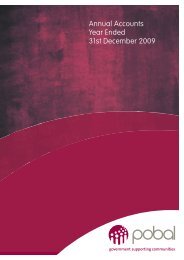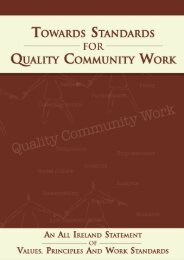Intercultural Education in the Post-Primary School - National Council ...
Intercultural Education in the Post-Primary School - National Council ...
Intercultural Education in the Post-Primary School - National Council ...
Create successful ePaper yourself
Turn your PDF publications into a flip-book with our unique Google optimized e-Paper software.
SCHOOL PLANNING 3ensure this is addressed at all stages ofschool plann<strong>in</strong>g and policy mak<strong>in</strong>g is tohave an <strong>Intercultural</strong> <strong>Education</strong> head<strong>in</strong>gfor every section of <strong>the</strong> <strong>School</strong> Plan, andfor each policy addressed <strong>the</strong>re<strong>in</strong>. As partof <strong>the</strong> plann<strong>in</strong>g process, reference shouldbe made to• <strong>the</strong> <strong>Education</strong> Act (1998)• <strong>the</strong> <strong>Education</strong> (Welfare) Act (2000)• <strong>the</strong> Equal Status Act (2000)• <strong>Education</strong> for Persons with Special<strong>Education</strong>al Needs Act (2004).Curriculum and assessmentHow <strong>the</strong> school manages curriculum andassessment is <strong>in</strong>formed by its educationalaims and objectives. The school’s broadcurriculum programme should besufficiently comprehensive and flexible toensure that <strong>the</strong> needs of all students arecatered for.<strong>Intercultural</strong> education promotes anengagement with a diversity of cultures forstudents of all ethnic groups and religions.As such, students of ethnic groups(m<strong>in</strong>orities and majority) become aware ofand develop <strong>in</strong>tercultural attitudes towards adiversity of cultures at <strong>the</strong> same time and <strong>in</strong><strong>the</strong> same way. It should be noted however,that <strong>the</strong> <strong>Education</strong> Act does not ‘require anystudent to attend <strong>in</strong>struction <strong>in</strong> any subjectswhich is contrary to <strong>the</strong> conscience of <strong>the</strong>parent of <strong>the</strong> student or <strong>in</strong> <strong>the</strong> case of <strong>the</strong>student who has reached 18 years, <strong>the</strong>student’. The place of <strong>in</strong>tercultural education<strong>in</strong> <strong>the</strong> school’s mission and <strong>the</strong> value to allstudents of engagement with a diversity ofcultures should play a key role <strong>in</strong> decisionmak<strong>in</strong>gon subject options and a schoolassessment policy. Such a context is alsoimportant <strong>in</strong> discuss<strong>in</strong>g that work withparents. Collaborative plann<strong>in</strong>g <strong>in</strong> relationto <strong>the</strong> <strong>in</strong>tercultural dimension of somesubject areas will greatly enhance <strong>the</strong>plann<strong>in</strong>g process.Please refer to Chapter 5 for fur<strong>the</strong>r<strong>in</strong>formation on <strong>the</strong> plann<strong>in</strong>g of lessoncontent and to Chapter 7 for fur<strong>the</strong>rdetails on assessment and cultural diversity.Includ<strong>in</strong>g <strong>in</strong>tercultural education <strong>in</strong> all areasof school plann<strong>in</strong>gIn addition to ensur<strong>in</strong>g that an<strong>in</strong>tercultural perspective is brought toreview<strong>in</strong>g exist<strong>in</strong>g elements of <strong>the</strong> schoolplan, <strong>the</strong>re are o<strong>the</strong>r areas that need to beaddressed <strong>in</strong> order to ensure that <strong>the</strong>school is an <strong>in</strong>clusive school. They <strong>in</strong>clude<strong>the</strong> follow<strong>in</strong>g:• <strong>in</strong>corporat<strong>in</strong>g an <strong>in</strong>tercultural and antidiscrim<strong>in</strong>ationapproach to staffdevelopment• ensur<strong>in</strong>g equality of access andparticipation• promot<strong>in</strong>g <strong>in</strong>tercultural education <strong>in</strong> <strong>the</strong>classroom• record<strong>in</strong>g and report<strong>in</strong>g racist <strong>in</strong>cidents• creat<strong>in</strong>g an <strong>in</strong>clusive physical and socialenvironment <strong>in</strong> <strong>the</strong> school• provid<strong>in</strong>g language support• provid<strong>in</strong>g age-appropriate placement ofnewcomer students <strong>in</strong> class groups• select<strong>in</strong>g appropriate resource materialfor learn<strong>in</strong>g and teach<strong>in</strong>g• celebrat<strong>in</strong>g special events <strong>in</strong> <strong>the</strong>calendars of a diversity of cultures• develop<strong>in</strong>g a communication policy:with<strong>in</strong> <strong>the</strong> school, between school andhome, and between home and school• develop<strong>in</strong>g a school charter thatcelebrates diversity and promotesequality.A review process that looks at <strong>the</strong> school’spractice <strong>in</strong> response to <strong>the</strong>se issues willenable <strong>the</strong> school community to establishclear development priorities and toundertake specific action plann<strong>in</strong>gactivities that will enhance <strong>the</strong> educationalprovision for all students.<strong>Intercultural</strong> <strong>Education</strong> <strong>in</strong> <strong>the</strong> <strong>Post</strong>-<strong>Primary</strong> <strong>School</strong> 27
















